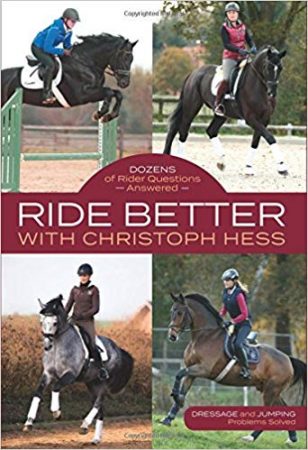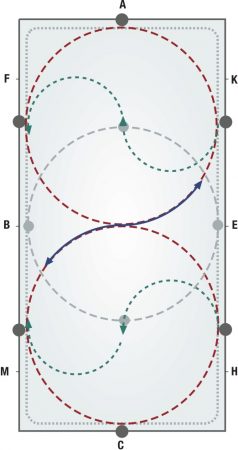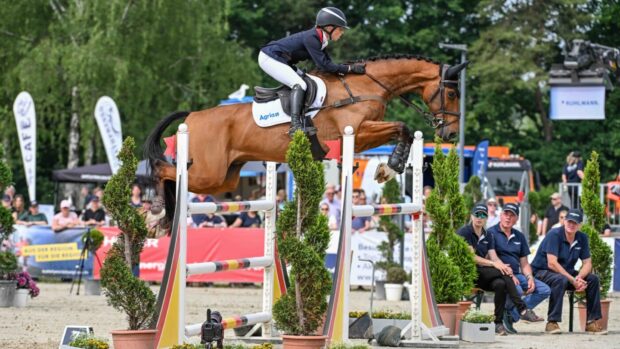Ride Better with Christoph Hess, is a new book, out now, which is full of helpful tips and pieces of advice for riders and their horses whether they are interested in dressage, eventing or showjumping.
Christoph (pictured top) is an FEI I judge in both dressage and eventing and is highly respected around the world as a trainer too, adhering to classical principles. Here he picks out problems and sticking points he finds most common when training horse and rider and shares his advice in a very easy-to-follow manner.
No matter what level you are riding to, this book is a must-read. Throughout Hess emphasises that a rider must always strive to improve, for the simple reason that they can always do better for their horse.
Taken from a extract of the book, here Christoph helps one rider whose horse has become a ‘wiggleworm’:
“My six-year-old gelding has a large build (17.3 hands) and is sensitive and sometimes too motivated under saddle. I have the problem that he gets crooked under saddle. When riding the whole arena, he goes more like a three-year-old, drifting from side to side and not at all straight. I can hardly even turn him onto a bending line. He ignores my weight aids. What can I do to get him to stop this drifting and be able to ride him without problems in both directions?”
“First thing’s first: a six-year-old horse is still developing. His training is far from complete. Each horse has his own difficulties, which the rider must compensate for through training.
“I need to begin by congratulating you that your horse responds with such sensitivity. This is a good condition for getting far with him as a riding horse.
“With your gelding, we are talking about an “over-motivated” horse that measures 17.3 hands high. As a general rule, larger horses have bigger problems finding their balance under saddle than smaller ones do. Therefore, you will need to give your gelding time. It requires time for him to find his balance underneath you in all three basic gaits (walk, trot, and canter). So, just as it would be more difficult for a gymnast who suddenly grew a lot to gracefully coordinate and balance on all the gymnastic equipment than it would be for a smaller gymnast, it is more difficult for your large, growing horse to coordinate the movement of his body than it is for a smaller, more nimble horse.
“On the positive side, your horse is equipped with good motivation.
Maintaining motivation
“As a rule, it is easier to work with highly motivated horses because they like to go and naturally like to move. You want to utilise this quality in your horse as it will make his training much easier. Horses that are less motivated are much more difficult to ride than those who are “too motivated,” as they wait for the rider’s aids to “request” that they execute the different exercises. This can be tiring for the rider. Generally speaking, the rider will not have the same enjoyment riding a horse like this as she will when riding a horse that likes to move.
“With your horse, you must always keep one important tip in mind: no matter what, you must not try to “tame” or “control” your too-motivated horse by using dominant rein aids. If this transpires, you will destroy the horse’s pleasure in working with you. Instead, you’ll have a horse that “rebels” against you. This rebellion can lead to resistance and to definite difficulties with riding (for example, a tight neck, a horse that fights the bit, or one that runs away out of control). All of these problems cause loss of suppleness and balance.
“Make sure that you maintain an even feel on both of your horse’s sides with your calf muscles. This allows you to have a quieting influence on your over-motivated horse, while at the same time he will wiggle less and straightness will improve.
“Based on this, here’s my best advice. View your motivated horse’s enthusiasm for movement as something positive; give your horse the freedom to move forward beneath you in a controlled manner. In this way, you will have a fantastic partner over time, one with whom you can have great success.
Balance is key to success
“Your youngster does not yet have the balance to move without drifting from side to side when you’re on his back. Young horses should first be ridden around the track following a lead horse or along a track with an outside fence or wall. The lead horse should give the young horse confidence and trust. The outside fence or wall helps the young horse find his balance under saddle.
“Yes, turning onto a circle can pose a real challenge for a young horse. Many young horses fluctuate (fall out or in). Horses are especially prone to this along the “open side of the circle” (the side not against the rail), as here there’s no fence on which to “lean.” We can compare the support provided by the track in an indoor arena, or the fence in an outdoor, to the support that a handrail provides us when we cross a narrow bridge over a raging river. If we tried to cross this bridge without the benefit of using the handrail, there’s the danger that we would lose our balance pretty easily and fall into the river. In contrast, holding onto the handrail helps us to cross over safely with more confidence. The danger of falling in the river has been minimised. If we are absolutely determined to cross the bridge without holding on to the handrail, we must practice diligently—and in your case, this is exactly what I suggest.
“My second piece of advice: for now, you should consistently ride your gelding on the second or third arena track—meaning not directly on the rail or fence. Every line travelled where your horse can’t “lean” on the rail for support will help him more and more to find his natural balance under saddle. This is an important prerequisite to being able to ride turns well, as you must also execute bending lines without the support of an outside boundary.
“It’s important that you start out riding with your upper body in a slightly forward position and your gaze (and head) turned in the direction of travel. In this way, you “share” with your horse the direction that you want him to go. This also has the effect of orienting your weight slightly in the direction of travel, without you even realising it. Your six-year-old gelding will respond to your—so-called—one-sided weight aids. You can support this action by implementing an opening rein on the inside. To do so, move your inside hand toward the centre of the arena, but you must avoid any tendency to pull backward!
Circles, serpentines, and company
“Initially, you should ride your horse on bending lines—large and small circles, as well as voltes. Once that is working, you can begin riding shallow serpentines down the long side of the arena and serpentines with three and later four loops through the whole area (assuming the small arena size of 20 by 40 metres). Therefore, in the first stage of training, you’ll stay tracking in one direction at a time; in the second stage, you’re incorporating changes of directions in the ring figures. Changing from one bending line of travel to another is a special challenge for the horse in relation to maintaining his steady balance.


The pictures above show just some of the possibilities for riding turns and bending lines
“Through these exercises, the horse will learn to stretch more and more through his whole body as well as use his neck for balance. Eventually, he will be able to move just as well on tracks where he doesn’t have the support of the rail as he moves when travelling in the track along the rail.
“What to keep in mind? You may not change the direction of travel by using your rein aids (so not by applying more inside rein); instead you must try to primarily utilise your weight aids. In doing so, avoid driving excessively with the seat. Your gaze in the new direction is enough, along with allowing your horse to turn in this direction especially since you describe your horse as extra sensitive.
“In the first phase, you should initiate the change of direction predominantly by shifting your weight. In the second phase, more leg aids will be required to support the seat. In doing so, your inside leg has the job of bending the horse onto the bending line and helping him to maintain his balance throughout the turn. The outside leg and outside rein have a “guarding” role here, preventing the horse from falling out.
“Many riders unknowingly shift their weight to the outside (so, the wrong side) — either deliberately or, for example, by overzealous use of the outside leg. In this way, you give your horse unclear information as to which line of travel he should take. The more the horse drifts to the outside, the more this rider will then tend to unknowingly implement (pull on) the inside rein, which only exacerbates the problem. This causes a vicious circle, which can be broken through correct application of the weight aids.
Article continues below…
You might also be interested in:

‘On this yard I’m God, and God says we’re here ready to feed at 6am’: the real life of a stable lass
From brutally long hours, interesting characters (both human and equine), falling in love with horses to the jockeys starving themselves,
Last word
“As riders, we must remain aware that we are our horses’ trainers — regardless of our own riding level. An important element of success is how much and how effectively we apply our weight, leg, and rein aids.
“This applies in a special way to your horse because he brings the necessary sensitivity to the table. If you use your weight aids incorrectly, your horse can become unbalanced and begin to drift from side to side because of the disruption to his balance.”
BUY NOW: £19.95 paperback via Amazon
Published by: Quiller Publishing, 2018
For all the latest equestrian news and reports, don’t miss Horse & Hound magazine out every Thursday




